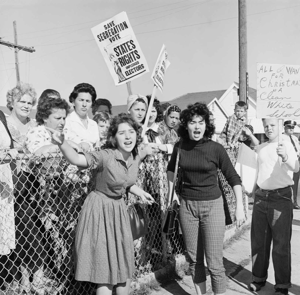Essay

Let’s Not Allow White Tears to Take Priority over Children of Color
Teaching is hard. Conversations about race and racism are hard. Put them together, and sometimes people cry. But let’s not allow tears from white women to overshadow the needs of children.
Years ago, someone forwarded me a copy of an academic paper: "When White Women Cry: How White Women’s Tears Oppress Women of Color." In it, author Mamta Motwani Accapadi wrote, “the White woman’s reality is visible, acknowledged, and legitimized because of her tears, while [the reality for people of color] is invisible, overlooked, and pathologized based on the operating ‘standard of humanity.”
This disparity is an outgrowth of what the author calls white women’s “one up/one down” identity—one aspect is privileged while another is oppressed. As Accapadi observed, “White women can be both helpless, without the helplessness being a reflection of all White people, and powerful, by occupying a position of power.”
I read this paper with a feeling of such relief. Before reading this, I had been uncertain about how to navigate situations when white women cried in schools.
To be clear, the issue isn’t that a white woman is crying. People cry. Crying is not the problem.
The problem is how education systems, schools, school leaders, and the managers of school leaders react to white tears and reinforce oppressive beliefs and behaviors, which then undermine adults’ focus on serving children.
It seems rare that we openly discuss how white tears—and all forms of white defensiveness when challenged about bias—affect leadership practices. But without such open discussion, leaders can be ill-equipped to respond equitably to situations involving a white woman’s tears.
Examining this topic is an opportunity for schools, particularly those with a high percentage of middle-class, white female staff members serving Black students from lower-income backgrounds, to bridge the gap between theory (examining white privilege) and practice (accelerating advancements in social justice with Black children).
White Tears Can Get in the Way of Educational Justice
In her article, "Tears and Fears: White Women and Social Justice," author Maura Cullen described her experience taking part in a workshop where a woman of color was providing Cullen with feedback regarding her racist behavior. “As my tears fell, an African-American man came to my rescue. He is a dear friend and trusted colleague. However, my tears left him in a tough spot, forcing him to make a decision as to whom he should support, me or the woman of color. It was a no-win situation for him. He chose me and had to deal with the fallout.
But what consequences did I experience? None. Where was my fallout? The people of color were left to sort it out as I watched uncomfortably on the sidelines, not sure of what to do.”
My question: what if the racist behaviors being addressed were behaviors that impacted children? A sudden shift to consoling the white female would take the focus off the central issue, which is how the racist behavior is an obstacle to social justice.
Too often, in such a situation, what’s better for white women takes precedence over the needs of Black children.
Children are pushed aside in favor of a white woman’s concerns.
Educators from all backgrounds may be less likely to see a problem or advocate for a solution for Black staff and children when their concerns aren’t pleasing to white colleagues. Fixing white women’s feelings when they have an issue may take priority. This needs to change.
People of Color Can Be Pressured into Silence
Deference toward White women can also happen when Black people feel internal and external pressure to side with the White person even when they don’t agree with her. If you’re a Black person managing another Black person, consider this: negative associations commonly thrust upon Black people and Black culture in the U.S. can color how we Black people view each other.
Blacks and whites receive the same narratives and images that perpetuate stereotypes of Black criminality and frivolity, while equating white culture with American values. As a Black manager, you could be internalizing negative messages about other Black people and elevating the concern of the White woman above the Black staff person, even when you think the Black person is right.
So, what can education organizations, school systems, schools, school leaders, and school leader managers do to ensure that we are not allowing white women’s tears to slow the advancement of equity for Black children?
There are actions we can take, starting with self-reflection and moving into making changes in our interpersonal relationships, our team management and how we manage systems more broadly. Here are some ideas.
Self-Reflection: If you are a leader that has allowed white tears to dictate the focus in school conversations, prepare to be uncomfortable. Change can be hard. But it is possible if school leaders and their leaders are actively modeling how we should prioritize the needs of children and their families above the feelings staff may have.
Self-Reflection: A teacher shared, “If there was more transparency in the classroom, I don’t think there would be as many tears. ‘I’m White. I know I have certain privileges. I am here to help you to pursue your dreams. I know that my skin color allows me to get away with things that you probably won’t get away with. I know I have biases. And I want to be honest about that.’”
Interpersonal Relationships: Allow the staff member to cry. Reschedule the conversation if need be, but keep the focus on what is best for students and families. Ensure that all parties are aware of that unyielding focus.
Self-Reflection & Interpersonal Relationships: The book "Cracking the Corporate Code" shows how 32 Black executives navigated the challenges of power relationships in white-dominated business culture. Many of those norms are also relevant to schools. The book includes a thorough analysis of power in organizations, including three particularly relevant kinds of power: associative, which involves relationships with powerful people; assertive, which involves acting as if one has the right to power; and positional, which means the person’s role in the organization gives them the right to make certain decisions.
When reflecting on how schools respond when white women cry or otherwise defensive when challenged, it is helpful to consider how their “one up/one down” identity reveals itself through these three kinds of power. For example, a white woman might observe them this way.
Associative: My white femaleness gives me greater access to those in power, particularly White men;
Assertive: I am accustomed to being listened to above Black children and families, and
Positional: My whiteness is valued and therefore allows me to have a position above others in decision-making conversations even when those others are my managers) and the degree to which this power is used to serve the causes of educational equity or to distract from it.
Here’s a key question for self-reflection: As a white woman, am I working to be more conscious about how my privilege can be harmful or helpful to educational equity?
Team Management: In weekly check-ins and reflections, ask colleagues and managers to hold you accountable to staying focused on big-picture issues. Ensure managers who report to you also hold their direct reports accountable.
To do this among people of color, you can discuss these questions:
As a person of color, am I acting in ways that show I have internalized racism? As a manager or colleague, am I allowing white tears to distract me from what is best for families and students? Am I speaking up when I feel that I have been dismissed due to a white woman’s defensive, emotional responses?
Systems Management: All educators need training on the historical implications of how white women have been perceived in this country, why that is so, and the impact this perception has on interactions between staff, parents, and students so that students have broader access to opportunities.
In the article, "Lessons I Will Teach My White Daughter," author Sara Tansey pledges “to start a conversation [with her daughter] about how exactly we raise white children to make different choices about how to live with and use their white privilege.” and includes several historically-grounded reflections on being a white woman in America.
Systems Management: A necessary element of bringing understanding across larger organizations like schools and districts is to offer differentiated training on privilege. One educator said, “White women need to go to a training about their privilege. Give them tools to combat their perceptions of disrespect. Respect seems to be a big deal. Teachers send students out of the room all the time for disrespect. White teachers need to give respect to get it and understand what respect means for the community the teacher is serving.”
Many schools and school systems have done the foundational work to examine elements of identity in ways that are truly transformational. If we really want to move in the direction of equity for Black children, education organizations, schools, school districts, and school staff have a responsibility to consider more deeply the ways in which we consistently manage and engage with adults in an effort to pursue exceptional educational experiences for all children of color in urban environments.
Examining our response to white tears is a great place to continue this work so that we minimize distractions from what matters most, student and parent needs.

As Chief Learning Officer for The Center for Black Educator Development, Dr. Kelli Seaton is an innovative, visionary, outcomes-oriented educational leader who is passionate about educational equity and committed to ensuring that children of color experience learning environments that actively embrace results in academic achievement, cultural proficiency, critical consciousness and community activism. She previously served as a principal with Mastery Charter School-Pickett Campus where she led efforts to improve student outcomes and as Vice President for Teacher Leadership Development with Teach for America, where she managed a team of coaches and leaders serving more than 200 corps members in Trenton, Philadelphia, and Camden.


